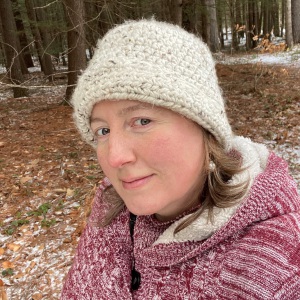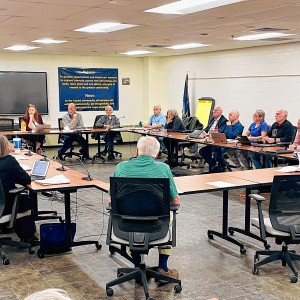Francestown ZBA denies Davis Lane variance

Phillip Lawrence (left) and his lawyer Jason Bielagus (right) observe the property as the Francestown Zoning Board of Appeals explores the woods past the rock wall during a walk-through of their David Lane property in August. —STAFF FILE PHOTO BY AIDAN BEAROR
| Published: 09-29-2023 7:50 AM |
On Sept. 21, the Francestown Zoning Board of Adjustment denied Richard Lawrence’s variance application for property located on Davis Lane in a 5-0 vote.
Lawrence was looking for relief from the 400-foot front setback required for back lots and the 100-foot setback from wetlands. He bought the property in 1999, and his son Phillip was looking to build a single-family residence with approximately 3,000 square feet of usable space and standing between 28 and 29 feet tall. Phillip Lawrence, his wife, two children and mother-in-law would live there.
ZBA Chair Silas Little suggested the board address the front setback variance first, saying that “if they can’t meet the criteria for the one, the other issue will basically go away.”
Little explained that, in order for the board to grant the variance, the applicant must meet each of five criteria established by state law: that the variance will not be contrary to the public interest, special conditions exist such that literal enforcement of the ordinance results in unnecessary hardship, the variance is consistent with the spirit of the ordinance, substantial justice is done and the variance must not diminish the value of the surrounding properties.
In a brief filed with the ZBA, Lawrence’s attorney Jason Bielagus argued that the variance should be granted because residential use was permitted on the lot and that Lawrence was proposing to build a residence. Bielagus further argued that the lot was narrow and contained wetlands, and the length of the driveway needed to meet the setback would require additional permits, thereby creating a hardship.
The board reviewed each of the five criteria. At Little’s suggestion, they began with a discussion of the hardship criteria. Board member Cindy St. Jean said there were reasonable alternate building locations on the lot that could meet the town’s zoning, so she saw no hardship.
Little also noted that the applicant was aware of the configuration of the lot when he bought it, and that there was nothing specifically unique about the property. The board agreed unanimously that the applicant had not met the hardship criteria.
Little explained that, because all five criteria must be met, the board could deny the application solely on the hardship finding. St. Jean said that she would like the board to discuss each of the five criteria.
Article continues after...
Yesterday's Most Read Articles
 Peterborough voters approve funds for fire and rescue station
Peterborough voters approve funds for fire and rescue station
 HOMETOWN HEROES – Rose Novotny is motivated by community
HOMETOWN HEROES – Rose Novotny is motivated by community
 Mt. Monadnock Little League celebrates opening day
Mt. Monadnock Little League celebrates opening day
 ConVal committee begins to study withdrawal process
ConVal committee begins to study withdrawal process
 Mascenic custodian named statewide 'Champion for Children'
Mascenic custodian named statewide 'Champion for Children'
 L. Phillips Runyon III – Personal freedom and the common good
L. Phillips Runyon III – Personal freedom and the common good
Board Member Sue Jonas spoke on the sprit of the ordinance, justice and the public interest. She said that three similar back lots located in her neighborhood had been developed in recent years, and all of them had met the requirement of the zoning ordinance. Jonas contended that the building location proposed by the applicant was not in keeping with the stated purpose of the ordinance to “retain the present character of simple rural beauty” in the district and therefore did not meet the spirit of the ordinance.
Board member Stuart Brock said he believed that “if we grant this variance, it would in fact be inconsistent with the spirit if the ordinance.”
Little pointed out that important consideration had been given to the lot configuration at the time the subdivision was approved. Front and back lots had been approved with required setbacks for each. He said substantial justice would be to respect the process and findings of the original subdivision.
In the discussion of the fifth criteria, diminishment of value, the board acknowledged that they had received testimony on both sides of this issue. A majority of members agreed that none of the evidence was probative.






 PHOTOS: Peterborough hosts Children and the Arts celebration
PHOTOS: Peterborough hosts Children and the Arts celebration Superintendent Kimberly Rizzo Saunders leaving ConVal School District
Superintendent Kimberly Rizzo Saunders leaving ConVal School District Meg Gourley – Village improvement societies do what needs to be done
Meg Gourley – Village improvement societies do what needs to be done PHOTOS: New Ipswich marks Memorial Day
PHOTOS: New Ipswich marks Memorial Day
